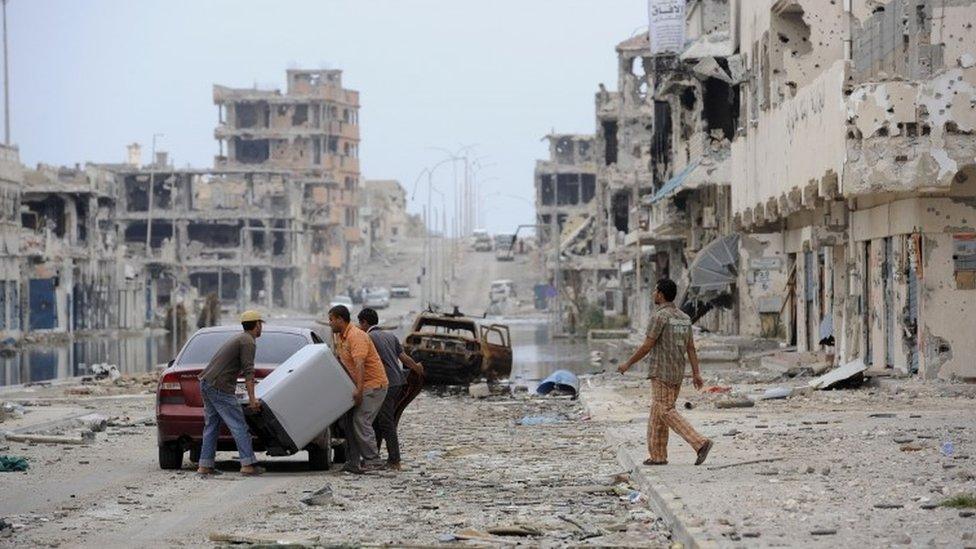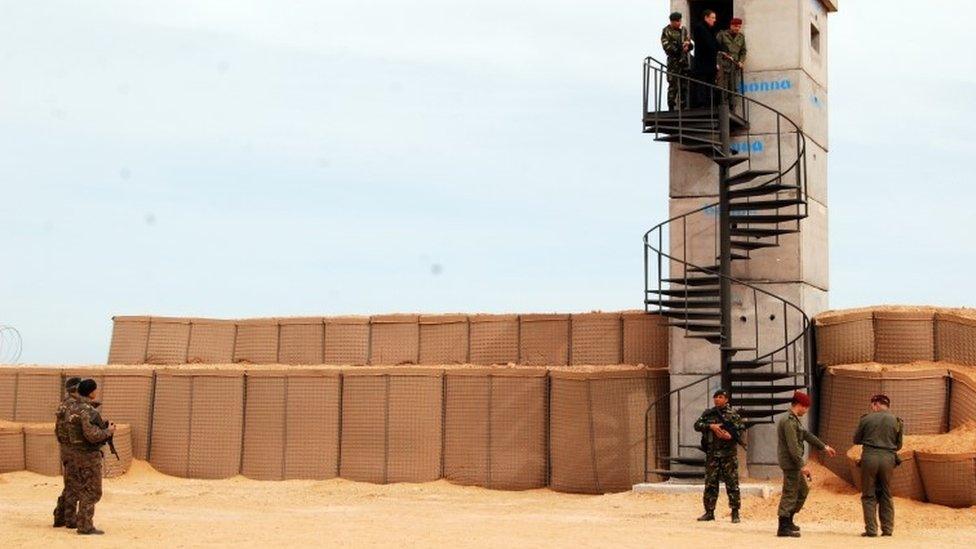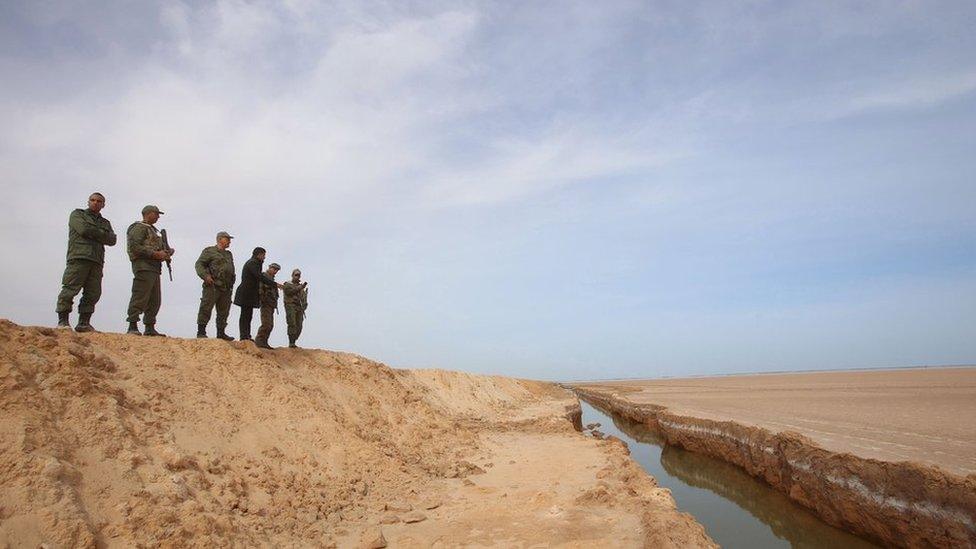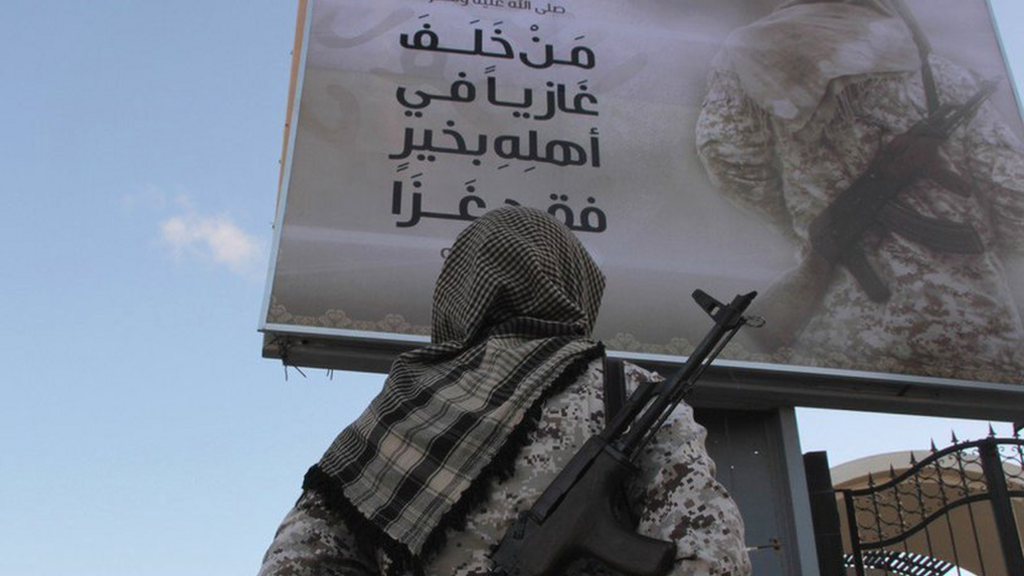Islamic State foothold in Libya poses threat to Europe
- Published

IS militants have seized territory around the city of Sirte
Counter-terrorism officers in the Metropolitan Police are increasingly concerned that so-called Islamic State's foothold in Libya could become a second springboard, after Syria, for attacks on the UK and the rest of Europe.
As the US-led coalition steps up air strikes on IS positions in Syria and Iraq there are growing fears that the IS "enclave" around the Libyan city of Sirte is providing a safe haven in which jihadists can train, fund and plan attacks across the Mediterranean. So how real is this threat?
Last week the US State Department and the Pentagon jointly raised their estimate of the number of foreign jihadists with IS in Libya to 4,000-6,000. They believe large numbers are being recruited from African countries to the south, helped by cash inducements.
There is no question that Libya offers IS a convenient second base after Syria, something it started scouting out as far back as 2014 by covertly sending "emissaries" to make contact with jihadists in the east of the country.
Libya today is awash with powerful weapons and there are unlimited places in which to train jihadists for future terrorist attacks, with little chance of being disrupted by any kind of central authority because there isn't one.
Both IS and Western governments have made much of Libya's proximity to southern Europe, pointing out that it brings the group geographically much closer to the West than its bases in Raqqa or Mosul.
Gruelling journey
But in fact, when it comes to access to Europe, Libya is a lot less convenient for IS than it appears on the map.
On its western border the Tunisian government has just completed the first part of a border security barrier aimed at preventing the sort of devastating attacks on tourists carried out in Tunis and Sousse last year.
There will still be ways round the fence, further to the south, but it makes the international crossing much harder. Libya shares a long, 989km western border with Algeria, but the authorities there have been assiduous in pursuing Islamist groups inside their borders and have assigned thousands of extra troops to patrol the Libyan border.

Tunisia has erected the first part of a barrier along its border with Libya
To the east is Egypt, where the secular government of President Abdul Fattah al-Sisi has vowed to crush the Islamist insurgency in his country and where Apache helicopter gunships patrol the western desert close to the Libyan border.
To the north is, of course, the Mediterranean, hardly an impenetrable barrier, but Western analysts still assess that IS will be reluctant to risk sending trained operatives by sea on a boat overloaded with migrants if they can find a safer way into Europe.
That still leaves nearby Malta and the wide open borders to the south but the latter entails a gruelling journey across the Sahara Desert and the risk of arrest in a Sahel country such as Niger or Chad.
Turkey's blind eye
Compare this with the ease with which IS jihadists and recruits have been able to travel between Syria and Europe.
Those heading for Raqqa in Syria have been able to buy cheap plane tickets to Istanbul, pretending they are going on holiday, with no need for a Turkish visa in advance, then meet up with a fixer who directs them to either a bus or internal plane journey down to a border town like Gaziantep.
From there, smugglers who know every loophole in the border take them across into IS territory.
Meanwhile, contrary to the initial assessment of European intelligence agencies, a small number of IS operatives heading the other way have been able to hide themselves among the mass movement of migrants travelling from the Middle East and up through the Balkans into western Europe.
Today the Turkish-Syrian border is a rather less benign crossing point for IS jihadists. Kurdish militia groups control much of the Syrian side of that border while Turkey, which has long been accused of turning a blind eye to jihadists passing through, has now tightened up its border controls significantly.

IS fighters attacked a Libyan oil terminal at Es Sider in January
So where does this leave Libya and the possibility, as feared by the Met Police, that the situation on the ground there will lead to a new wave of attacks on the UK and Europe?
UK officials in Whitehall say that until now there is no evidence of IS operatives leaving Libya to target Europe, nor of attack planning on the UK from Sirte, the IS centre of operations in Libya.
But they also caution that IS in Libya is still on an upward curve in terms of growth and consolidating its powerbase.
Just as IS in Syria and Iraq first concentrated its efforts on taking territory and disposing of local enemies, IS in Libya is currently doing the same.
But the expectation in Western capitals is that once that phase is over it will be only a matter of time before attacks are planned and dispatched from Libya.
"We know it's coming down the track," said one official. "It's just a question of when."

IS in Libya

IS seized a strip of land along Libya's coast, around the city of Sirte, last year
Libyan intelligence officials say foreign fighters and some IS commanders have relocated there from Iraq and Syria
The US estimates the number of IS foreign jihadists at 4,000-6,000
The largest groups are said to be from Tunisia, Egypt, Sudan and Iraq; there are smaller numbers from many other countries
Recent recruitment has focused on sub-Saharan African countries
It is not known how many of the jihadists are nationals of European countries
IS has attacked Libyan cities, including Tripoli and Benghazi, and oil installations

- Published3 February 2016

- Published7 February 2016

- Published3 February 2016

- Published11 January 2016
